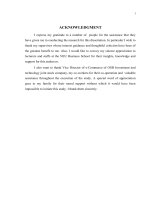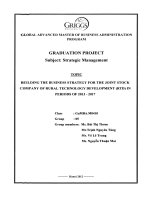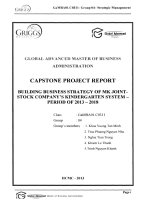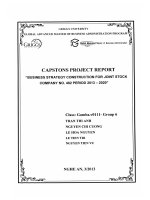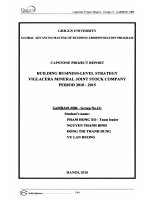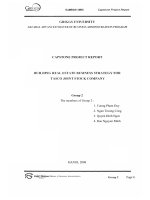32 DEVELOPING SALES STRATEGY AT VACOM JOINT STOCK COMPANY
Bạn đang xem bản rút gọn của tài liệu. Xem và tải ngay bản đầy đủ của tài liệu tại đây (424.54 KB, 55 trang )
MINISTRY OF FINANCE
ACADEMY OF FINANCE
--------
STUDENT: NGUYEN THI NGOC ANH
GROUP: CQ55/51.01
RESEARCH PROPOSAL
TOPIC:
DEVELOPING SALES STRATEGY AT VACOM JOINT STOCK COMPANY
Major:
English for Finance and Accounting
Student code: 1752220201003
Supervisor:
M.A. Phan Thi Ha My
Ha Noi, 2021
Graduation Thesis - Academy of Finance
TABLE OF CONTENTS
Nguyễn Thị Ngọc Anh – CQ55/51.01
Page 2
Graduation Thesis - Academy of Finance
DECLARATION
I, Nguyen Thi Ngoc Anh, being a student of Faculty of Foreign Languages, hereby
certify my authorship of the thesis submitted today entitled:
Thesis: “Developing sales strategy at VACOM Joint Stock Company”
I declare that the thesis and the study presented in it are my own and have been
generated by me as the result of my own original research.
Hanoi, May
, 2021
Graduation thesis author
Nguyễn Thị Ngọc Anh – CQ55/51.01
Page 3
Graduation Thesis - Academy of Finance
ABSTRACT
This graduation thesis examined sales strategy at VACOM joint stock company. The
study was conducted based on theoretical background of sales strategy and current
situation of business strategy at VACOM joint stock company. The thesis was done
with the implementation of documentary review, the questionnaire survey and
SWOT analysis. From this constructive approach, the study sought to investigate
the difficulties in sales strategy and solutions proposed to improve business strategy
at VACOM joint stock company.
Nguyễn Thị Ngọc Anh – CQ55/51.01
Page 4
Graduation Thesis - Academy of Finance
ACKNOWLEDGEMENT
First of all, I would like to express my deepest thanks and gratefulness to my
supervisor, Mrs. Phan Thi Ha My M.A., lecturer of the Faculty of Foreign
Languages, Academy of Finance. Her kindly support and continuous advices went
through the process of completion of my thesis. Her encouragement and comments
significantly enriched and improved my work. Without her motivation and
instructions, the thesis would have been impossible to be done effectively.
I acknowledge my thankfulness to all staffs at VACOM joint stock company who
have supported, helped and provided me valuable suggestions and data during
internship period. Without their helps, it would be impossible for me to finish this
thesis.
I also would like to show my sincere thanks to all the lecturers in the Faculty of
Foreign Languages of Academy of Finance for tireless devoting time and efforts to
enrich, broaden and deepen my knowledge over the past four years. My heartfelt
gratitude goes as well to the Faculty of Foreign Languages of Academy of Finance
for giving me the opportunity and permission to implement this thesis. I
furthermore thank to all the lecturers who will mark and give constructive
comments on this thesis.
My special thanks approve to my parents, my colleagues and my friends for their
advice and encouragement to me. I also deeply thank to all the people whose direct
and indirect support assists me to accomplish my thesis in time.
Thank you all, in advance.
Nguyễn Thị Ngọc Anh – CQ55/51.01
Page 5
Graduation Thesis - Academy of Finance
LIST OF ABBREVIATIONS
%
PBT
Co., Ltd
Nguyễn Thị Ngọc Anh – CQ55/51.01
Percent
Profit before tax
Limited company
Page 6
Graduation Thesis - Academy of Finance
LIST OF FIGURES AND TABLES
Nguyễn Thị Ngọc Anh – CQ55/51.01
Page 7
Graduation Thesis - Academy of Finance
INTRODUCTION
1. Rationale of the study
In the market economy with the current strong globalization trend, customers have
more conditions to access innovative products and services that are constantly
innovating along with the development of the department learn technology. To
attract customers and dominate the market, each company uses different methods
and the goal of administrators is to make differences. Therefore the closure of loss
companies and the development of highly effective companies significantly depend
on business strategy of that company. Strategy is a word derived from the military
field, which is the way to win a war. However, the social is growing and strategic
thinking is not dedicated only in the military field, business activities also use with
the elements like strategy and leadership. Recently, Johnson and Scholes (2008)
defined that strategy is the direction and scope of an organization over the long
term: which achieves advantage for the organization through its configuration of
resources within a changing environment, to meet the needs of markets and to fulfill
stakeholder expectations.
Obviously, in an area where consumer needs are constantly changing such as
information technology especially software supply, sales strategies need a lot more
special attention. According Vietnam economic news (2018), Information
technology (IT) has been growing at an impressive rate of 30 percent per year,
playing an important role in Vietnam’s socioeconomic development. Aware of this,
more and more businesses are entering the information technology field. This also
means that competition between companies becomes increasingly fierce. Therefore,
in order to attract customers and dominate the market, each company uses different
methods. Because in the consumer's mind, the "winner" emerges with the important
characteristics that satisfy their needs, the goal of administrators is to make
differences. Thus, each company needs to find its own methods and effective
strategies to be able to develop sustainably and strongly.
Nguyễn Thị Ngọc Anh – CQ55/51.01
Page 8
Graduation Thesis - Academy of Finance
As a business enterprise in the field of information technology, production of
accounting software, all activities of VACOM Joint Stock Company are through the
sales network. Therefore, for the company, building a reasonable and effective sales
strategy has a direct influence on the existence and sustainable development of the
company. From the above perception, and the trend of the business environment as
well as the current situation at VACOM Joint Stock Company, at the same time,
being aware of the practical importance of business strategy for businesses, I have
carried out the topic "Developing sales strategy at VACOM Joint Stock Company"
as the topic for my thesis with hope to be able to come up with some solutions to
help VACOM Joint Stock Company develop a more effective sales strategy.
2. Aim of the study
The thesis was concentrated on how to develop sales strategy at VACOM joint stock
company by answering two questions below:
1. What was the current situation of sales strategy at VACOM joint stock company?
2. How to develop an appropriate sales strategy at VACOM joint stock company?
3. Scope of the study
Due to limited time and space, as well as limited practical experience, the strategic
direction was only within 2 fiscal years of 2019-2020. In particular, the main task
was to focus on developing sales strategies with high potential for efficiency. The
study would be conducted with the participation of the head, the sales team leader
and 18 sales staff from the sales department of the VACOM joint stock company
4. Methodology of the study
There were two main methods used in this study, including (1) documentary review
and (2) questionnaire survey
Firstly, the author collected the material by researching books, magazines,
newspapers or websites related to sales strategy from reliable sources, then,
Nguyễn Thị Ngọc Anh – CQ55/51.01
Page 9
Graduation Thesis - Academy of Finance
proposing to develop better and more reasonable in developing a sales strategy for
the Vacom Joint Stock Company.
Secondly, questionnaires survey was designed to collect information from
employees of VACOM Joint Stock Company and customers about the current
situation of sales activities at the company, thereby offering solutions to develop an
appropriate sales strategies. The questionnaire consisted of two parts. Part A
included 2 questions. The first was about the frequency of activities to develop sales
strategy, including: searching for potential customers, exploiting the market,
managing distribution channels/ agent systems, making weekly sales plans and
reports, proposing new sales plans and organize daily sales management. The
second was about the effectiveness of current sales activities. Questions focused on
evaluating the company's sales process, including pre-sales, while-sales and postsales. Part B was to propose solutions to build an appropriate business strategy at
VACOM Joint Stock Company.
Besides, SWOT analysis is also used to analyze the strengths and weaknesses of
current business activities, thereby identifying opportunities as well as threats to the
company. This method was created in the 1960s by Albert Humphrey of the
Stanford Research Institute, in a study conducted to determine why business
planning repeatedly fails. Bonnie Taylor, director of marketing strategy at CCS
Innovations, told Business News Daily: “It's impossible to accurately map the future
of a small business without judging it from all angles, including a holistic view of
all. both internal and external resources and threats. "A SWOT accomplishes this in
four simple steps that even rookie business owners can understand and grasp.”
5. Organization of the study
Besides the Introduction, Conclusion and References, the thesis consists of three
main section:
CHAPTER 1: Literature review refered to the theoretical background on sales
strategy
CHAPTER 2: The study focused on the current situation of sales strategy
VACOM joint stock company
Nguyễn Thị Ngọc Anh – CQ55/51.01 Page 10
Graduation Thesis - Academy of Finance
CHAPTER 3: Recommendations was organized with recommendations, the
orientation and solutions to develop business strategy at VACOM joint stock
company
CHAPTER 1: LITERATURE REVIEW
Chap 1 presents the general theory related to sales strategy and provides a basic
background of sales strategy in Information Technology industry in Vietnam. It
includes three main parts. The first part is about overview on activities to develop
sales strategy in Information Technology industry in Vietnam. The second part
consists of measurement and assessment of sales strategy. The third part provides
data about factors affecting sales strategy of the company.
1.1. Overview on developing sales strategy in Information Technology industry
in Vietnam
1.1.1. Overview on sales strategy in Vietnam
1.1.1.1. Definition of sales/ sales strategy
There are many related concepts that are understood by many administrators in
many different ways. Although the skills required are different, from a management
viewpoint, according to Philip Kotler (2000), sales means a part of marketing. Sales
often form a separate grouping in a corporate structure, employing separate
specialist operatives known as salespersons. Sales are considered by many to be a
sort of persuading "art". In the business dictionary, the definition of sales is as
follows: The activity or business of selling products or services, or an alternative
term for sales revenue or sales volume. Sales is not about trying to convince
potential customers, or developing the most persuasive tactics to get people to part
with their money. When this is your business strategy, people can sense it - and it is
a bit of a turn off. The aim of sales is to provide a timely and cost-effective solution,
which naturally equates to a win-win situation.
According to business dictionary, the definition of a sales strategy is “a planned
approach to account-management policy formation, prospect identification and
qualification, sales presentation, and order generation aimed at achieving a firm’s
Nguyễn Thị Ngọc Anh – CQ55/51.01 Page 11
Graduation Thesis - Academy of Finance
sales quotas or targets”. Besides, according to marketing dictionary, sales strategy
sets out a detailed plan on how to get the product and service in front of the right
people who need it. Sales strategy is based on business plans and marketing
strategy. Sales strategy is important in allocating sales resources efficiently in
driving selling costs down and marking up the revenues. Besides, in 1962 Chandler,
one of the people who initiated and developed the theory of strategic management
said that: strategy is the identification of targets and long term goals of the business,
and the acceptance of the action sequences as well as the allocation of necessary
resources to implement this goal.
In short, although each administrator has its own approach to research, it should
express different concepts, but in the end, it still revolves around the following main
contents: Sales strategy means an approach to selling which allows the sales team of
an organization to position the company and its products to the customers in a
differentiated and more meaningful way. Many strategies have an in-depth line of
best practices as well as processes that are given by management. Sales strategy
focus on defining short-term and long-term goals of the business, making a plan to
achieve the goals and selecting of policies and implementation and allocation of
resources to achieve that goal.
1.1.1.2. Types of sales strategy
According to David Gargaro (2020), there are generally two types of sales
strategies which are employed by a business: direct or indirect.
Direct Sales Strategy: Direct sales strategy involves selling your products or
services directly to the customer, who would make purchases through your sales
staff, in your store, on your website, at a trade show or through mail order. In a
direct sales strategy, sales people while talking to the consumer attack their
competitors head on. They try to compare each feature of the competitor’s product
and compare it to theirs. The term direct sales approach also refers to ‘negative
Nguyễn Thị Ngọc Anh – CQ55/51.01 Page 12
Graduation Thesis - Academy of Finance
selling’. A direct sales business removes the middlemen involved in product
distribution, like a regional distribution center and wholesaler. Instead, products go
from the manufacturer to the direct sales company. If you are a distributor (i.e. a
sales representative) working with a direct selling business, then the manufacturer
gives you the products to ultimately sell to the consumer.
Types of direct sales strategy:
Person-to-person sales: arranging individual appointments with customers to make
presentations, demonstrate new products or arrange product tests or fittings
Door-to-door sales: approaching homes and businesses by appointment or
unannounced to leave catalogues and offer products or product demonstrations
In-home presentations : arranging parties and at-home gatherings to present
products (often called 'party plan')
Online shopping: using websites and email lists to build customer networks and
offer online ordering facilities
Venue sales — setting up booths or kiosks at events to generate new leads and
promote and sell products
Network marketing — recruiting other sellers into a network to 'duplicate' your
product sales role, earning a percentage of their sales revenue and expanding your
product reach.
Indirect Sales Strategy: Indirect sales involve using a third party (e.g., partner,
affiliate, distributor) to sell your company’s products or services. Customers could
purchase your products or services at physical locations (e.g., retail stores,
warehouses) or online (e.g., resellers’ websites, Amazon). In other words indirect
sales approaches are more subtle in nature and are implemented by demonstrating
Nguyễn Thị Ngọc Anh – CQ55/51.01 Page 13
Graduation Thesis - Academy of Finance
features and benefits that are not available with the competitor’s products or
services without ever mentioning about any competitor’s products. This technique is
more sophisticated. Indirect sales strategy can be an effective way to increase your
footprint without hiring additional staff. Indirect sales occur through a third party,
such as a partner, affiliate or distributor. Businesses rely on indirect sales to grow
sales without hiring additional sales staff. Indirect sales reduce control over the
product or sales process and require sharing revenues.
How does indirect sales work?
Indirect sales enable your company to increase sales quickly without hiring
additional sales staff. You can combine both direct and indirect sales approaches to
sell your products or services, where indirect sales will support what your in-house
sales personnel are doing. You can also use indirect sales to expand into new
markets or grow your existing markets. Some companies will use indirect sales to
handle an increase in demand for its products or services, which would be more
efficient than hiring more experienced salespeople.
Indirect sales channels
There are four main types of indirect sales channels:
Affiliates are companies that sell products or services in exchange for a
commission. This includes third parties that serve as intermediaries to link the
company to affiliate sellers. Affiliates are only paid when they make a sale. You can
provide affiliates with advertising and marketing tools for increasing traffic and
growing the business.
Resellers sell directly to customers in face-to-face settings (e.g., retail stores,
wholesalers, dealers), representing the manufacturer of the product. This is a
common practice in the software and hardware industries. For example, a customer
Nguyễn Thị Ngọc Anh – CQ55/51.01 Page 14
Graduation Thesis - Academy of Finance
might purchase a smartphone from a telephone and Internet service provider’s store
(the reseller) rather that the manufacturer’s store. Resellers are typically paid
through a margin percentage or profit percentage on each sale.
Independent sales representatives are individuals who are hired on an as-needed
basis to sell the company’s products or services. They can be added or removed as
needed, which lowers the company’s overhead. One common example is an
insurance agent who is paid on commission for the generation of new customers
and renewal business.
System integrators are consultants who provide customers with specific solutions
to their issues. They typically work in B2B product or services sales. For example, a
system integrator might work with a company that provides hardware and software
products as well as tech advice, and would provide sales and consulting services.
1.1.1.3. Activities to develop a sales strategy
Searching for potential customers
As a business owner, you're no doubt keenly aware that your client base is the
lifeblood of your company. A steady stream of new customers allows you to grow
your business and fulfill your company vision. Former OPEN Forum community
member Farzana Irani also realizes the importance of a strong client base for all
small businesses, including virtual ones. "Attracting more customers is really about
listening to their needs, not being a solution looking for a problem," says Paige
Arnof-Fenn (2008), founder and CEO of Mavens & Moguls, a strategic-marketing
consulting firm whose clients include Fortune 500 companies as well as early stage
and emerging businesses. "There are many existing problems out there that need to
be solved that customers are willing to pay for today."
Exploiting the market
Exploiting the market runs the gamut from very simple qualitative research to indepth quantitative analysis. It can be done very quickly and inexpensively by
Nguyễn Thị Ngọc Anh – CQ55/51.01 Page 15
Graduation Thesis - Academy of Finance
sending surveys to your existing customers using one of the many online survey
tools. But depending on the questions you are trying to answer and your research
budget, your market research can involve more extensive interviews with
customers and qualitative studies on how target customers feel about your
business, its products and services. Certain products and services may appeal
to one audience but not to another, so understanding the strengths,
weaknesses, opportunities and threats in your target market is critical.
Managing distribution channels/ agent systems
1.1.1.4. The importance of sales strategy in business operations
Strategic management helps businesses clearly see their goals and directions,
specifically to see the opportunities and advantages in business, take
advantage of them to make appropriate development strategies and policies to
achieve the goals. title out.
The environmental conditions in which the business operates are always changing.
Strategic management helps managers predict current and future uncertainties and
risks so that they base on enterprises' potentials to proactively deal with these
situations.
Strategic management helps administrators to effectively use the enterprise's
resources and allocate them appropriately.
Strategic management coordinates the functions of an enterprise in the best way on
the basis of achieving the common goals of the business.
1.1.2. Overview on Information Technology industry in Vietnam
Vietnam’s information technology is still young but it has been becoming in
rapid growth. Following the regional countries in the region such as India and
the Philippines, the IT outsourcing services in Vietnam is developing gradually.
According to Vinasa, Vietnam’s outsourcing enterprises have made inroads
gingerly into the markets of the US, Japan and several European countries over
the years, and generate around $3B a year. Furthermore, according to the Japan
Nguyễn Thị Ngọc Anh – CQ55/51.01 Page 16
Graduation Thesis - Academy of Finance
External Trade Organization, in recent years, Vietnam has overtaken India to
become Japan’s second-largest software outsourcing partner after China, which
accounts for around 21% of the market.
In particular, software outsourcing industry is increasing faster in the next three
to five years. For years, some giant multinational corporations like Intel, LQ,
Nokia, IBM, Samsung, and Microsoft have chosen Vietnam to outsource their
software products and move an inflow of high-tech manufacturing operations to
Vietnam. According to the Ministry of Information and Communications,
Vietnam exported $3.5 billion worth of software in the previous year.
To understand such strong growth, and what is contributing to it, we examine five
sub-sectors that show potential and are currently trending in Vietnam’s IT sector.
Fintech
A rising middle class, growing internet usage, and a young population present a
great combination for the fintech sector to thrive. An estimated 120 companies and
brands cover a wide range of services, from digital payments to wealth management
and blockchain.
Digital payments is the most popular segment, with mobile payment apps MoMo,
Moca, and Zalo Pay leading the way. Peer-to-peer lending (P2P) is also becoming
increasingly popular, with Tima, Growth Wealth, and Trust Circle among the most
popular.
Blockchain and cryptocurrency is the third segment in this sector that is
increasingly gaining traction. Several companies like TomoChain and Kyber
Network deal in cryptocurrency, allowing consumers faster and cheaper
transactions. In 2018, Vietnam held its first-ever international conference on
blockchain and its potential for development in the country.
Nguyễn Thị Ngọc Anh – CQ55/51.01 Page 17
Graduation Thesis - Academy of Finance
Artificial Intelligence
The artificial intelligence sector (AI) industry in Vietnam shows strong potential.
While still developing, AI in the country has followed global trends in application to
human resources, education, healthcare, agriculture, transport, and e-commerce.
A good example of how AI is being used domestically can be found in Vietnamese
conglomerate FPT Corporation, which has used AI for smart traffic in Ho Chi Minh
City. Viettel Group has used AI in endoscopy for their operations in Vietnam. Viettel
is also using AI to fight cyberattacks and help businesses deal with internal IT
security.
In August, the government issued Resolution No.50-NQ-TW, encouraging FDI by
increasing the number of businesses to 50 percent by 2025 in advanced technology
and Industry 4.0 – this could help develop AI further.
E-commerce
Vietnam’s e-commerce market could be ranked third after Indonesia and Thailand
by 2025, according to the E-Business Index 2019 report by the Vietnam ECommerce Association.
Vietnam’s e-commerce activity is most active in Hanoi and Ho Chi Minh City. Sales
from these cities account for 70 percent of the country’s total. This represents a
significant opportunity to penetrate rural markets – rural internet connectivity is
strong, and a majority of the population lives there.
Domestic e-commerce firms such as Shopee, Sendo, and Tiki operate websites that
compete with regional players like Lazada and Shopee. Consumers also use social
media like Instagram and Facebook for e-commerce.
Nguyễn Thị Ngọc Anh – CQ55/51.01 Page 18
Graduation Thesis - Academy of Finance
Over the last four years, Vietnam’s internet economy has attracted over US$1
billion in funding, but customer trust, high competition, and logistics costs remain
challenges for e-commerce companies in the country.
Software outsourcing
Software outsourcing has gained traction over the last decade in Vietnam.
According to a survey by US-based software vendor BetterCloud, 73 percent of
organizations will use software outsourcing.
Vietnam has emerged as a cheaper outsourcing destination compared to traditional
markets, such as China and India. This helped the software industry reach revenues
of US$8.8 billion in 2018, according to the Vietnam Software and IT Services
Association.
The government is developing high-tech parks and is also offering several
incentives to further the industry. For example, Da Nang has developed as a
software outsourcing center, particularly for Japanese businesses.
Still, challenges exist, and Vietnam needs to develop large scale IT outsourcing to
compete with global players. In addition, more attention will be needed to improve
English speaking skills to cater to global firms.
Education technology
Vietnam’s education technology (Edtech) has received investments worth US$55
million in 2018. This investment is largely driven by Edtech centers’ ability to
bridge the gap between traditional education environments and learning needs
inspired by the private sector.
Most recently, Vietnamese startup Everest Education secured a US$4 million
investment by a Hong Kong-based equity firm. Organizations like Everest
Nguyễn Thị Ngọc Anh – CQ55/51.01 Page 19
Graduation Thesis - Academy of Finance
Education provide tech-enabled personal learning through a network of centers and
partner schools.
Vietnam’s kindergarten through grade 12 population is a large market with locals
spending up to 40 percent of their disposable income on education. Edtech firms
like Violen.vn, Hocmai.vn and Topical have found success in this space. It’s no
surprise that foreign investors from Japan, Singapore, South Korea, and Australia
are showing interest.
1.1.3. Sales activities in Information Technology industry in Vietnam
The outlook for Vietnam’s information and communication technology (ICT)
market is strong at an average growth rate of 8 per cent during 2016 to 2020. The
ICT industry (especially software and services where there is huge potential for
increased adoption by enterprises and public sector) is expected to grow
tremendously as Vietnam has emerged as a production center for both IT hardware
and services such as software development outsourcing.
The Vietnamese Government has identified ICT as a key sector contributing to the
country’s development and has devised a Master Plan for Information Technology,
which specifies targets for 2020 and aims at turning Vietnam into an advanced ICT
country. The government has pledged to invest approximately US$ 415 million
from the State Budget in the ICT sector by 2020 (Source: BMI Vietnam Information
Technology Report 2016 ) .
There are four major ICT focus areas, addressing supply as well as demand:
Improving policy environment
Developing IT human resources
Developing IT enterprises and trademarks, products and markets
Attracting investment into build IT zones and open source software.
Nguyễn Thị Ngọc Anh – CQ55/51.01 Page 20
Graduation Thesis - Academy of Finance
Companies operating in the Vietnamese ICT market can enjoy support measures
from the government such as tax incentives and simplified administration
procedures. New hi-tech parks are set to be constructed between 2015 and 2030
through a combination of central government direction, local government funds and
private capital. Enterprises located in software or hi-tech parks are offered further
support and incentives. The growth of hi-tech parks is expected to generate demand
for IT products and solutions directly while contributing to the broader dynamic of
economic modernisation.
Remarkably, the software sector is growing at an average rate of 30 per cent per
year with over 1000 companies operating within the sector, employing around
70,000 people. In recent years Vietnam has emerged as a destination for software
outsourcing, competing with India, China and the Philippines. As a software
outsourcing destination, Vietnam ranks 8th according to a research report from AT
Kearney. The Vietnamese software market is cost-sensitive, with around 75 per cent
of the market served by lower-cost local software providers. Local software
enterprises tend to serve the government and small and medium enterprises, while
larger Vietnamese companies are more likely to rely on the higher-priced software
offered by multinationals. Multinationals have a 25 per cent share of the local
software market (Source: BMI Vietnam Information Technology Report 2016 .)
Areas of opportunities include CRM, business intelligence, ERP, human resource
management, data analytic and database/datacentre software, especially in the
banking and finance sector.
1.2. Measurement and assessment of sales strategy
1.2.1. Methods of assessing the effectiveness of sales strategy
In 2016, according to Vanessa Cross- a business writer, who claimed that a sales
strategy is the game plan to attain sales goals and objectives. After you reach your
goals, assess the effectiveness of the sales strategies used to reach them. This will
Nguyễn Thị Ngọc Anh – CQ55/51.01 Page 21
Graduation Thesis - Academy of Finance
evaluate how well a firm has taken advantage of market opportunities using sales
staff and capital resources for advertising and promotions to maintain customers
and grow market share.
•
Review the original sales goals and objectives. Sometimes the original goals and
objectives change during the implementation process -- without the express
intention of the sales team. For example, a sales goal to increase the level of
quality customer service might change from a customer orientation to a sales
orientation as salespersons focus more on revenue-related objectives, such as
increasing prospecting and cold calling.
• Identify performance gaps in the sales goals and actual outcomes. This is the
business examination of your sales goal at the end of the deadline set for its
achievement. For example, a quantitative sales goal, such as to increase sales of
Widget B by 15 percent in fourth quarter 2011, can be evaluated at the end of the
period by reviewing financial and sales reports for Widget B against the sales
goals.
• Evaluate the effectiveness of promotional sales strategies. Sales promotions
campaigns are designed to impact a company's market share. For example, the
success of promotional efforts specifically geared to increasing market exposure
for Widget B can be assessed based on increases in sales for Widget B after the
promotional efforts were implemented. In addition to evaluating sales of Widget B
against sales goals, variance analysis might be used to compare sales for Widget B
against its historical sales for the same period in years past. The data used for this
type of quantitative assessment includes sales and financial reports.
• Review sales staff performance. This includes review of the specific sales goals
for individual staff members and teams. It also includes looking at timescales set
for sales plans against actual performance data to determine whether sales
strategies were timely executed. A sales plan budget should also be reviewed
•
against actual costs for implementing the sales plan.
Calculate the internal rate of return on the sales plan. This is a quantitative
evaluation tool that helps in measuring the cost efficiency of investments. Here,
Nguyễn Thị Ngọc Anh – CQ55/51.01 Page 22
Graduation Thesis - Academy of Finance
the total costs for implementing the sales plan would be expressed as a percentage
of the total amount the sales plan is estimated to yield for the company during the
•
same period.
Perform qualitative analysis of sales performance. Qualitative data is nonnumerical and includes data gathered from techniques such as surveys and focus
groups. The most useful data for evaluating a sales strategy is often obtained
through open ended questions. For example, if your company provides B2B
services, conduct a written or telephone survey of business clients to gather their
opinions regarding customer service during the relevant sales period.
1.2.2. SWOT analysis
This is a tool developed by Albert Humphrey in the 1960s and it is a great tool to
help you develop your strategy. SWOT stands for Strengths, Weaknesses,
Opportunities and Threats. SWOT analysis will allow visualize both external and
external factors that can have an impact on your business in a very simple way. This
tool can help examine external factors influencing your business, opportunities and
threats, as well as internal factors, strengths and weaknesses. SWOT does not just
look at the enterprise as a whole, but it serves as a starting point for developing
strategies for sales teams, service departments and individuals. Steve Ferrante is the
CEO and Trainer of Champions of Sale Away LLC., providing Pinnacle
Performance sales, customer service and leadership training, speaking and
professional development services. In 2015, he wrote that one of the best ways to to
gain a clear understanding of how your organization is currently performing is to
conduct a SWOT analysis. As a strategic-planning management tool, a SWOT analysis
evaluates the 4 areas represented by the letters of the name:
S = Strengths
W = Weaknesses
O = Opportunities
Nguyễn Thị Ngọc Anh – CQ55/51.01 Page 23
Graduation Thesis - Academy of Finance
T = Threats
STRENGTHS
(positive attributes external to
INTERNAL
the organization/team/project
that are within its control )
OPPORTUNITIES
(external factors that the
EXTERNAL
organization/team or project
should develop)
WEAKNESSES
(internal factors within an
organization/team/project’s control
that may reduce its ability to meet
objectives)
THREATS
(external factors beyond the
organization/team’s control that
could place the project or
organization at risk)
Figure 1.2.1: SWOT Analysis
The SW analysis mainly analyzes the comparison between the product’s internal
environment and competing products in these possible areas of Quality, Price,
Process, Capability, Sales/Services. To begin with, strengths: the reasons why
customers choose your products or services over your competitors. These could be
the price point, the benefits of your products, or your customer service. You should
focus on these selling points to distinguish your offerings. Next, weaknesses:
aspects in which your products or services pale when compared to your
competition. For example, maybe your competitors are offering a better price point
or a higher quality product. Understanding these weaknesses can help you prepare
for objections while adjusting the sales approach to focus on your strengths in your
sales communications.
Nguyễn Thị Ngọc Anh – CQ55/51.01 Page 24
Graduation Thesis - Academy of Finance
Besides, to adapt to the market and the environment, we must constantly improve
ourselves. To adapt to the ever-changing environment and avoid fighting the Red
Sea, the products must be upgraded to process iteratively for a company to remain
competitive. Opportunities: areas in which you can make improvements to your
products, provide better services to your customers, expand into new markets, or
edge out some of your competitors. Your opportunities are often informed by your
strengths and weaknesses -- e.g., how you can better leverage your strengths to
attract more customers or improve on the weaknesses to become more competitive.
Finally, threats: risks in your sales and marketing strategy that could impact your
company's profitability. These risks could be external, such as customers switching
to a different brand because of pricing. Or they could be internal, such as the
inability to deliver the right messaging to your target market, which could isolate
your customer base. After you have identified the threats, you'll be able to devise
solutions to lessen their impacts.
1.3. Factors affect sales strategy
1.3.1. Internal factors
In 2019, Sarah Ireland-CEO of One Girl in Australian have studied it thoroughly
and shown that when facing challenges, the last thing you want to do as a business
owner is selling your business. So if you’re not making good sales, it’s high time to
study the internal factors that affect your sales performance. Internal factors
essentially originate within your business or company, which also reflects your
response to changes in the market.
The growth of the sales volume of a company has a direct relationship on how
internal factors are controlled. These internal factors include the company products,
marketing strategies, marketing personnel, technology and automation, e-commerce
multiple formats, suppliers, finances or resources, and the ability to tap consumers’
digital footprints.
Here are the details of each internal factor that may influence your sales in your
business:
Nguyễn Thị Ngọc Anh – CQ55/51.01 Page 25

